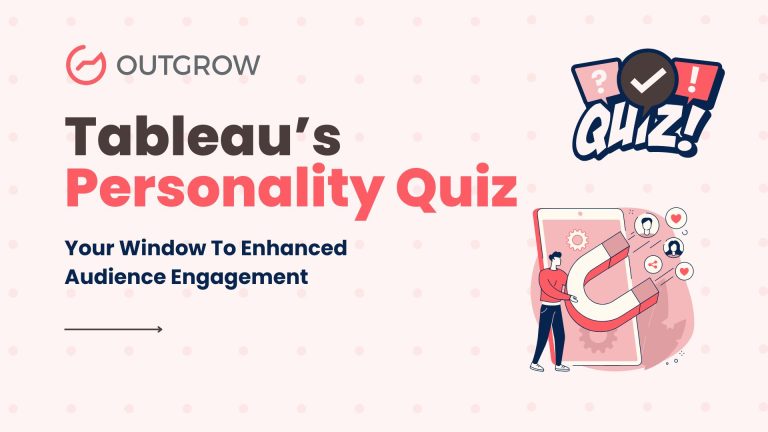6 Examples of Personalized Marketing to Get Ideas From [+5 Ways]
Table of Contents
Did you know that consumers are more likely to buy if they come across content that’s personalized? Yes, creating engaging and personalized content can help you boost your sales and your overall revenues! So here are some examples of personalized marketing strategies that have helped brands succeed.
Personalization has been discussed a lot in terms of how it can help marketers drive conversions, increase engagement, and improve customer loyalty.
But how can you implement it into your marketing strategy? Don’t worry, we’ve got you covered!
This blog will explain the basics of personalization, the benefits of implementing it, ways to conduct it, and 6 examples of personalized marketing from top brands to give you some inspiration.
What Is Personalization?
Personalization involves creating tailored messages for customers based on their needs and demands and engaging them. The aim is to use data to target and retarget leads with a specific message. All this is related to their interests, demographics, and behavior.
Personalization has become a major component of customer satisfaction and is relevant to both B2B and B2C marketers today.
Based on some important statistics given below, you should strive to create and promote personalized content as part of your marketing strategy.
What Is Personalized Marketing?
Personalized marketing, also known as individual or one-to-one marketing, is a strategy in which companies use data analysis and digital technology to send different custom messages to different consumers. It is an important tool to develop a company’s relations with its target market.
96% of business marketers say that personalization has helped them advance customer relationships and understand customer needs. Moreover, 88% say they have seen a considerable lift in business results.
However, marketing campaigns are only effective when they are personalized to the characteristics of the individual involved. Thus, it is crucial for marketers to know their audience before starting their personalized marketing journey!
Among the most important aspects of personalization is interactive marketing. The purpose is to help marketers personalize their marketing efforts by getting more information about their target audience via surveys, quizzes, polls, calculators, etc.
To kickstart things you can learn to create personalized interactive content on Outgrow. Sign up for your free trial now.
Benefits of Choosing Personalized Marketing
1. Boosts Brand Loyalty and Customer Retention
The consumer expects to be treated like a unique individual with specific preferences. Thus, companies that implement successful personalized marketing strategies keeping these preferences into consideration are able to gain a competitive advantage as well as greater customer loyalty.
Keeping up-to-date information about the users allows a company to continue to personalize messages and deliver relevant content. This leads to a better customer experience and helps in building brand loyalty and boosts customer retention.
Therefore, personalized marketing helps increase the customer’s lifetime value.
2. Helps Increase Revenue
Providing excellent content to customers through personalized marketing helps the company in improving its conversion rates, which in turn increases ROI.
With personalized offers, you can help make your users feel appreciated and special. This will encourage them to purchase from you and help increase your revenue and overall profits. You can also boost your sales by blending personalization with loyalty programs and sales promotions.
3. Improves Social Presence
Customers who receive positive personal interaction are more likely to share their experiences with their friends and family. They might also share it on social media.
This kind of positive reaction will help spread the good word about your brand. This will encourage more people to try out your business or product.
Hence, you can leverage personalized marketing through social media to increase customer satisfaction and brand loyalty.
4. Enhances Customer Experience
Personalized marketing helps in improving the customer experience by delivering personalized messages, products, and offers to the customers.
It is more relevant to deal with personalized content as it helps the consumers get what they want in less time. Thus, by making use of personalized content and offerings, you can provide value. And save the time that they would otherwise spend on conducting research.
This will help you attract and nurture new leads and also leave them with a sense of satisfaction.
5. Helps Create Better Content
Personalization marketing helps create content that’s easy to understand which leads to better engagement.
It utilizes specific information about the consumers and makes an offer that the consumer can’t say no to.
Examples of Personalized Marketing Campaigns
1. BustedTees
The marketing team at BustedTees developed a plan to personalize its email program in order to better serve its international customers.
It began by segmenting its emails based on the time zone, delivering them at a reasonable time for all the subscribers.
They used the past data on individual email open times to develop a personalized send time for each subscriber. Hence, the daily emails now reach customers at the times that are most convenient for them, regardless of their time zone.

As a result of implementing this practice, BustedTees saw an opportunity to grow and apply personalization along every step in the funnel. Implementing a personal send time has helped the team make operational improvements.
As a result of this personalization campaign, they achieved an 8% increase in email revenue overnight, an 17% increase in total email response rate, an 11% increase in clickthrough rate, and a 7.6% increase in post-click site engagement.
Thus, they were able to figure out how to bring more subscribers to the site through individualized email delivery.
They applied personalization knowledge to every phase of the conversion funnel, from email design to on-site experience, and checkout to post-purchase communications.
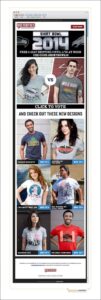
2. Grammarly
The welcome email sent by Grammarly informs customers about how to get the most out of their products, including how to use Grammarly across devices, tips for getting the most out of each service, and important preferences for newsletters and updates.
Thus, in addition to being a subscription notification, Grammarly’s welcome email acts as a handbook to set up customers for success.
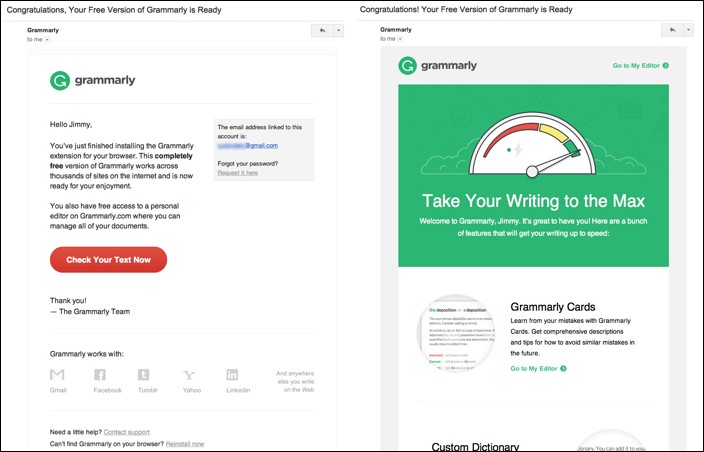
Through their Weekly Writing Update, Grammarly uses productivity reports to boost engagement from their users. The email includes a number of useful insights with a flair for gamification – from writing streaks and productivity to vocabulary and tone, it creates reports for everything.
In addition to offering a personalized and engaging experience, it also draws the users’ attention to the value they receive from the platform. This ultimately encourages them to continue using it.
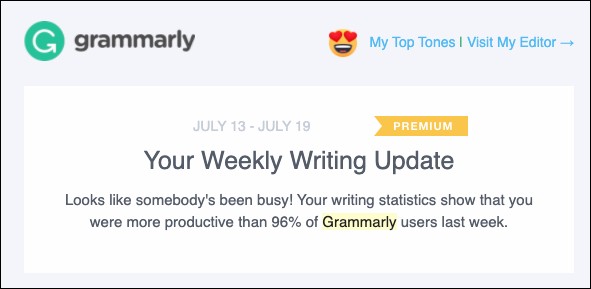
3. Amazon
By obtaining data by analyzing customer behavior, Amazon provides its customers with a personalized list of relevant products in order to drive further sales.
Furthermore, they ask their customers for feedback on these lists in order to refine them even more by using their preferences and letting them control what they see and hear from the company. By doing this, they are able to focus on the products they know their customers will be interested in.
A key part of their process is that Amazon shows product recommendations after the other products are purchased. They are very careful not to break the customer’s buying mentality to avoid any switch or return of products.
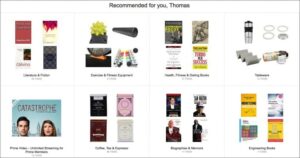
5. Birchbox
Birchbox, a subscription-based company that provides cosmetics and skincare products, uses hyper-personalization to get subscribers to consider buying their products. They do this by analyzing their subscriber data and creating specific messages and recommendations in order to engage their members.
They have also been able to personalize their customer service by using social media and the customer data they collect.
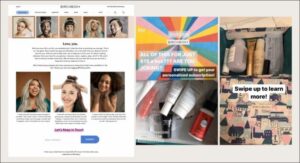
Instead of focusing on a fixed marketing strategy, Birchbox adapts to customers’ responses to specific products or box designs. In response to customer requests, Birchbox has also partnered with other websites, for example, they’ve collaborated with several designers from Etsy to create their own box designs in order to boost customer satisfaction rates.
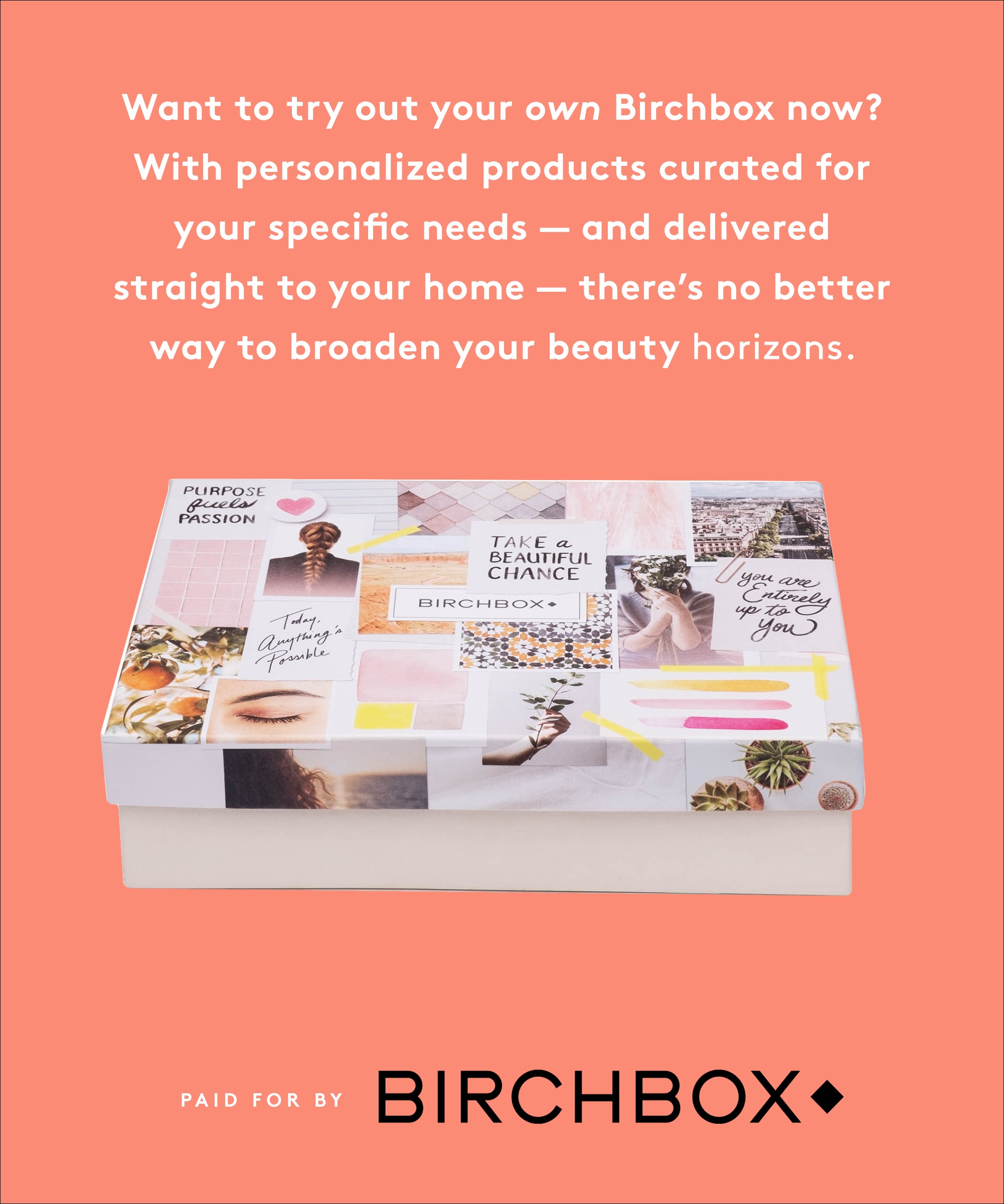
5. TripAdvisor
The TripAdvisor website takes the hassle out of travel planning with its suggestions and deals based on the visitors’ search history.
For instance, when people search the Internet for flights to a specific destination, a dynamic TripAdvisor ad appears with a competitive deal on accommodations at the destination.
TripAdvisor’s ads are customized in several ways based on factors like the flight to destination to the customer’s information form.
In addition to offering competitive deals on accommodation, they also use personalized marketing to increase conversions and interactions with their customers.

6. Pinterest
Sending push notifications is an excellent way to engage people and encourage them to take action. But to make it work, you must give them a reason to open the notification. That’s where personalization comes in.
Pinterest makes use of its users’ personal information and interests to send them targeted push notifications that encourage them to open and use the app. The more relevant and enticing the notifications, the more likely they are to be re-engaged.
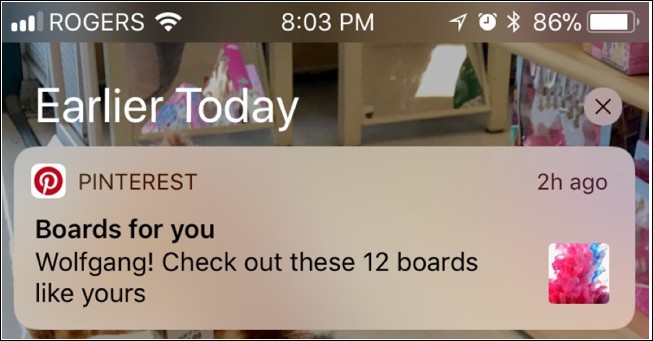
If you are a Pinterest user, you will see on your personalized page, a collection of words and topics based on your pinning activity. The difference, however, is not only the content but also how it looks and feels. Instead of uniformly sized pins, some sections are larger than others, likely indicating you’ve been pinning more around that specific topic.
Additionally, each category page in your personalized section shows which pins inspired each suggestion. The customized page has another benefit as well – it puts you in control of how you explore Pinterest, regardless of who you follow.
Woah! That was quite a list now – 6 power-packed examples of personalized marketing for you!
Now that we’ve discussed the most popular examples of personalized marketing strategies used by these reputed brands, let’s understand how can you implement personalized marketing in your campaigns.
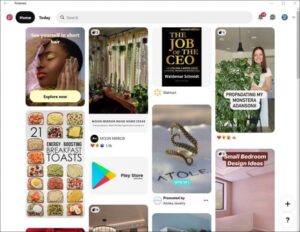
Ways to Implement Personalized Marketing
1. Emails
Personalized subject lines can improve email open rates. They can make content marketing messages feel more tailored to the recipient’s preferences and requirements. By leveraging the information you have collected from your audience, you can boost the effectiveness of your marketing efforts by personalizing your content based on specific users.
Thus, personalization helps boost email campaigns, allowing marketers to target specific audiences with individualized messages. To do this, having an understanding of your audience is extremely crucial, and signup forms are one way to begin collecting that information.
2. Surveys
Surveys help brands gather valuable data for decision-making and gain faster access to an array of client feedback.
With the help of surveys, brands can learn about the needs and preferences of their customers. This information will help them improve their personalized marketing efforts.
You can create a personalized survey to understand your customers using Outgrow’s survey maker.
Sign up for the free account and check it out for yourself!
3. Polls
A poll or question can easily capture attention and appeal to users to stop, think, and react. Polls and questions are good for engagement and lead generation.
In addition to delivering value, a social poll creates opportunities to engage with your audience. When you provide value, people are more inclined to share information with you. In fact, attaching a lead form may make the interaction feel more natural.
4. Quizzes
Quizzes are an excellent tool for businesses of all sizes to create more personalized experiences. They work best as top and middle-of-the-funnel content, which means they’re more likely to engage people who do not know about your brand.
In fact, 57% of consumers are willing to share personal information for customized offers or discounts.
Moreover, creating shareable moments with quizzes is very effective for companies. A good quiz shouldn’t only ask questions, it should also be conversational and engaging.
5. Social Media
It is not surprising that social media has become the backbone of multichannel initiatives. Through social platforms, brands have been able to keep in touch with potential customers online.
Hence, social media can be used to increase customer satisfaction and brand loyalty by interacting with consumers and potential customers.
Moreover, marketers can collect responses and customer data through social media channels by sending highly personalized and relevant messages through automation, which helps improve communication and drive conversions.
We’ve shown you the top six examples of personalized marketing and the path to implementing the personalization strategy in your business.
There’s no road, however, that comes without roadblocks. But the essence is to know how to overcome them. So here are some challenges in implementing personalization and how to tackle them.
Challenges in Implementing Personalization [+Solutions]
1. GDPR Compliance and Data Collection
The GDPR regulations have made it difficult for companies to collect customer data. The laws prohibit brands from collecting customer data without their consent. Thus, the companies must provide customers with easy-to-understand privacy policies and get their consent before extracting any information.
Thus, the companies must provide customers with easy-to-understand privacy policies and get their consent before extracting any information, especially considering GDPR requirements for US companies.
Customers can deny the data, which means that part of the personalization process may get lost.
As more and more ambiguous data privacy laws are written, the guidelines for what data you can and cannot collect and use have become more opaque.
The key to your first-party data collection is interactive content. Different tools are available to target different buyer personas, enabling and encouraging their engagement, for example, calculators, quizzes, infographics, etc. All tools can, in some way, contribute to data collection.
Try out Outgrow’s no-code interactive content builder and start your journey right away!
2. Segmentation
Segmentation is the core of a personalization campaign, but it is not as black and white as it appears. Maintaining and running effective retargeting campaigns through segmentation requires many complexities and nuances that are rarely considered.
Marketers often struggle to identify groups of the audience worth personalizing for in the first place, and without this, putting endless hours into personalization strategies fails to produce expected results.
Segmentation can be done properly by identifying the target market, then identifying the expectations of the target audience, developing a market product grid & estimating market sizes, and taking marketing actions to reach target markets.
3. Time and Technology
Although personalization is easy to grasp, technology makes it challenging to implement. Online marketers often report trouble finding tools that meet their needs.
Due to outdated technology, they struggle to find a smart personalization engine that meets all their needs. While the right software is essential for successful personalization, devoted employees are also necessary, and not all companies are able to put the resources, time, and effort into a successful personalization campaign.
As the number of data sources, engagement channels, and web & app properties grow, they go on adding technology and tools to support it. However, keeping them all together becomes overwhelming in no time.
Conclusion
So those were some real-life examples of personalized marketing for you to take inspiration from!
Content that matters to your potential customer will encourage them to provide you with more information and using that information, you can create content that matters even more.
However, when there is more content being created than people consuming it, the only way to stand out is through interactive and personalized content like quizzes.
Not only do they provide personalized and engaging experiences, but they also generate shareable moments that increase your website’s engagement and enhance traffic.
Hence, by creating customized and engaging experiences using Outgrow’s interactive content builder, you can not only generate leads but also encourage interactions that boost your website traffic and engagement.
Sign up for a 7-day free trial now and start personalizing your marketing efforts! And also let us know – will you try out these examples of personalized marketing for your campaigns? We’re eager to know! 🙂









